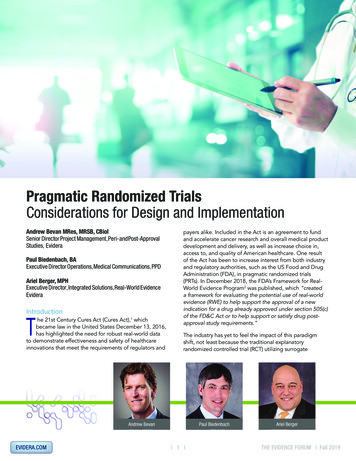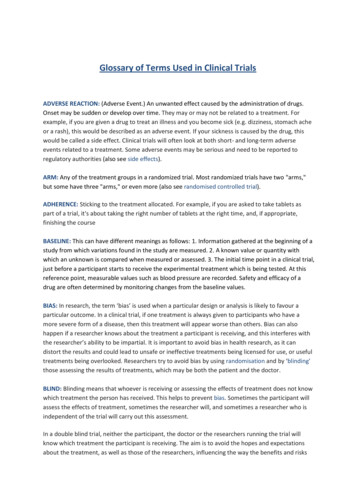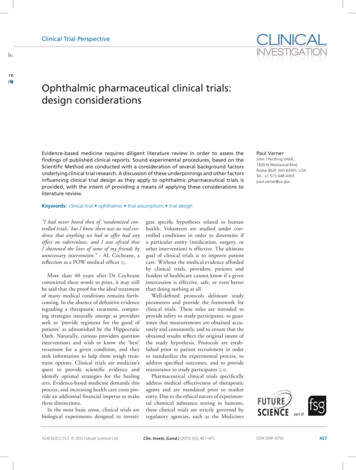
Transcription
Pragmatic Randomized TrialsConsiderations for Design and ImplementationAndrew Bevan MRes, MRSB, CBiolSenior Director Project Management, Peri- and Post-ApprovalStudies, EvideraPaul Biedenbach, BAExecutive Director Operations, Medical Communications, PPDAriel Berger, MPHExecutive Director, Integrated Solutions, Real-World EvidenceEvideraIntroductionThe 21st Century Cures Act (Cures Act),1 whichbecame law in the United States December 13, 2016,has highlighted the need for robust real-world datato demonstrate effectiveness and safety of healthcareinnovations that meet the requirements of regulators andpayers alike. Included in the Act is an agreement to fundand accelerate cancer research and overall medical productdevelopment and delivery, as well as increase choice in,access to, and quality of American healthcare. One resultof the Act has been to increase interest from both industryand regulatory authorities, such as the US Food and DrugAdministration (FDA), in pragmatic randomized trials(PRTs). In December 2018, the FDA’s Framework for RealWorld Evidence Program2 was published, which “createda framework for evaluating the potential use of real-worldevidence (RWE) to help support the approval of a newindication for a drug already approved under section 505(c)of the FD&C Act or to help support or satisfy drug postapproval study requirements.”The industry has yet to feel the impact of this paradigmshift, not least because the traditional explanatoryrandomized controlled trial (RCT) utilizing surrogateAndrew BevanEVIDERA.COMPaul Biedenbach 1 Ariel BergerTHE EVIDENCE FORUM Fall 2019
endpoints to establish efficacy and safety in a highlyselected population under optimal conditions has beenthe gold standard for researchers and regulators alike formany decades. These trials, which generate high-qualityrobust data with high intrinsic validity upon which tobase conclusions about causal relationships, answer theexplanatory question “is the intervention efficacious andsafe in tightly controlled, artificial conditions?” However,they ignore the more pragmatic question “is this an effectiveand safe option for my patient?” The pragmatic trial designwas developed to answer the latter, which is a key questionthat can inform potentially life-altering decisions required bypayers, clinicians, and even patients themselves.Unlike randomized trials, pragmatic studies use “typical”clinical settings to examine real-world outcomes suchas survival, utilization of healthcare services and/orpharmacotherapy, and overall cost of care. Most of theseoutcomes can be obtained from electronic health records(EHRs), which can shorten study timelines and reducebudget while still providing high-quality information.Pragmatic studies aim to generate evidence andconclusions based on real-world practice that are highlyrelevant to payers, healthcare providers (HCPs), andultimately policy makers as they look to gather informationto make treatment-related decisions. However, thesestudies have suffered from concerns of relatively lowinternal validity due to issues of outcome misclassificationand other forms of bias (e.g., selection bias, confoundingby indication). These issues can increase the risk of spuriousassociations between treatment(s) and associated outcomesrelated to effectiveness and/or safety, thereby reducing thereliability of the conclusions that can be drawn regardingcause and effect, and subsequently limiting their valueto regulators. Given the “low intensity” of investigatoroversight during the conduct of pragmatic studies, therealso are concerns around the quality of informationcollected – particularly, key outcome measures.Pragmatic Randomized TrialsPRTs represent a hybrid between traditional randomizedcontrolled clinical trials that have been the gold standard forregulatory decision making, and pragmatic, observationalresearch studies that are often used to generate real‑worldevidence to support health technology assessment(HTA) and payer decision making. A well-designed PRTthat maximizes external validity, but also controls forconfounding (including but not limited to selection bias)in order to maintain high levels of internal validity, couldtheoretically be used to generate evidence that wouldmeet both regulatory and payer requirements. A numberof tools have been developed to help researchers designpragmatic trials.3-5 One such validated tool is the PRagmaticExplanatory Continuum Indicator Summary Version 2(PRECIS-2),5 which is a 9-spoked wheel, with each spokerepresenting a domain that denotes a key element of trialdesign (Figure 1). Each domain is scored on a 5-point Likertscale ranging from explanatory to pragmatic (i.e., 1 veryEVIDERA.COMFigure 1. The PRagmatic-Explanatory Continuum IndicatorSummary 2 (PRECIS-2) Wheel (Adapted from Louden, et al.5)Primary analysisTo what extentare all dataincluded?EligibilityWho is selected toparticipate in the trial?54RecruitmentHow are participantsrecruited intothe trial?3Primary outcomeHow relevantis it toparticipants?2SettingWhere is thetrial beingdone?1Follow-upHow closely areparticipantsfollowed-up?Flexibility: adherenceWhat measures are in place to make sureparticipants adhere to the intervention?OrganizationWhat expertise andresources are neededto deliver theintervention?Flexibility: deliveryHow should the interventionbe delivered?explanatory, 2 rather explanatory, 3 equally pragmatic/explanatory, 4 rather pragmatic, 5 very pragmatic). Trialsthat are predominantly explanatory in their design generatespoke and wheel diagrams that are close to the hub,whereas those with a more pragmatic approach producediagrams that are closer to the rim. In reality, few trials arepurely explanatory or purely pragmatic, and for the mostpart, a well-designed PRT that maintains high levels ofexternal and internal validity will seek to strike an optimalbalance between the two study types, thereby producinga diagram that would be somewhere in the middle of thewheel (and potentially an “uneven” wheel, with aspectsmore pragmatic pulling the circle closer to the rim andthose more explanatory drawing the corresponding pointcloser to the hub). Representative diagrams for thesedesigns are shown in Figure 2. Design choices should bebased primarily on the research question(s) being posed; forexample, in a pragmatic cardiovascular outcomes trial, moreimportance may be placed on high scores on the Eligibility,Primary Outcome, Setting, and Follow-up domains, whereasa trial investigating an intervention in a post-surgicalintensive care setting may alternatively preferentially weightthe Recruitment, Flexibility-delivery, and Primary Analysisdomains.Real-World Outcomes and EndpointsOne of the challenges of designing effective PRTs is thechoice of outcomes and endpoints. The term outcome isused here to mean a measured variable or event of interest(e.g., time to first occurrence of a composite outcomesuch as myocardial infarction [MI], stroke, or cardiovasculardeath, which collectively are referred to as major adversecardiovascular events [MACE]), whereas an endpoint refersto an analyzed parameter that is expected to change over 2 THE EVIDENCE FORUM Fall 2019
Figure 2. Hypothetical PRECIS-2 Spoke and Wheel DiagramsA Retrospective Observational StudyPrimary analysisTo what extentare all dataincluded?EligibilityWho is selected toparticipate in the trial?54RecruitmentHow are participantsrecruited intothe trial?32Primary outcomeHow relevantis it toparticipants?SettingWhere is thetrial beingdone?1Follow-upHow closely areparticipantsfollowed-up?OrganizationWhat expertise andresources are neededto deliver theintervention?Flexibility: adherenceWhat measures are in place to make sureparticipants adhere to the intervention?Flexibility: deliveryHow should the interventionbe delivered?A Prospective Randomized, Double Blind Clinical TrialPrimary analysisTo what extentare all dataincluded?EligibilityWho is selected toparticipate in the trial?54RecruitmentHow are participantsrecruited intothe trial?32Primary outcomeHow relevantis it toparticipants?SettingWhere is thetrial beingdone?1Follow-upHow closely areparticipantsfollowed-up?OrganizationWhat expertise andresources are neededto deliver theintervention?Flexibility: adherenceWhat measures are in place to make sureparticipants adhere to the intervention?Flexibility: deliveryHow should the interventionbe delivered?A Pragmatic Randomized TrialPrimary analysisTo what extentare all dataincluded?EligibilityWho is selected toparticipate in the trial?54RecruitmentHow are participantsrecruited intothe trial?3Primary outcomeHow relevantis it toparticipants?Follow-upHow closely areparticipantsfollowed-up?Flexibility: adherenceWhat measures are in place to make sureparticipants adhere to the intervention?EVIDERA.COM21SettingWhere is thetrial beingdone?OrganizationWhat expertise andresources are neededto deliver theintervention?Flexibility: deliveryHow should the interventionbe delivered?time as a result of an intervention (e.g., change in LDL-Cfrom baseline). For a PRT to meet the requirements of bothregulators and payers, it is important that the selectedendpoints and outcome measures resonate with keystakeholders (patients, payers, regulators, and healthcareproviders), and be defined with sufficient sensitivity(typically more important for safety) and specificity (typicallymore important for effectiveness estimates) to translatethe trial objectives into precise definitions of treatmenteffect. In addition, endpoints and outcome measures thatare routinely available from EHR will render the study morepragmatic as it reduces the need to interact with thoserunning the study (each such interaction moves the patientfurther from typical care and more towards protocolmandated care).In the routine clinical setting, intercurrent events canoccur following an intervention – including treatmentdiscontinuation or switching, or use of alternative orcontraindicated medications – that can result in treatmenteffects being misinterpreted. Selecting endpoints andoutcome measures without first considering the impactof these intercurrent events will result in uncertainty overthe treatment effect, and potentially place a study at riskof not meeting its objectives. The impact of intercurrentevents can be controlled for by randomization; however, itmay not always be practical or even possible to randomizeon an individual subject level, but instead other methodsmay need to be employed (e.g., cluster randomization[randomizing at the site level] or crossover designs) whichcan add to complexity of the trial design and analysis. Biascan also be introduced into PRTs through lack of ability tomask treatments. This can be addressed to a certain extentby selecting clinically objective outcomes (e.g., stroke,hospitalization due to non-fatal MI, tumor size), but thismay not always be possible (e.g., in studies of Alzheimer’sdisease, where clinical outcome assessments [COAs] aresubject to human interpretation); moreover, structuralchanges (e.g., items measured using surrogate imagingendpoints) may not translate into clinically meaningfulchange. Ultimately the selection of a primary endpoint oroutcome will be driven by the research question(s) and howto best define the effect(s) of the treatment under studywhile controlling through design choices for the presenceof varied intercurrent events. This topic is addressed inICH-E9-R1, which introduces the estimand framework to linkthe trial objectives, the study population, and the variable(or endpoint) of interest to intercurrent events reflectedin the research question to more effectively translate thetrial objective(s) into a precise definition of the treatmenteffect(s) under investigation.6 This revision to ICH guidancewill undoubtably shape the approach to the design ofrandomized clinical trials, especially PRTs, in the future.The Rise of Health Informatics and Big DataThe increasing availability of rich EHR potentially linkableto medical claims data, and our ability to mine those datausing artificial intelligence (AI) and other advanced analytic 3 THE EVIDENCE FORUM Fall 2019
methods has expanded the possibilities for implementingembedded PRTs that reduce operational complexity,timelines, and cost, while still allowing for valid comparisonsbetween treatments. AI has enabled computablephenotypes with the precise clinical characteristics thatcomprise the relevant study population, and clinical andeconomic outcomes of interest, all from the same datasource(s). One example of a real-world data source thathas been widely used in the post-marketing evaluation ofmedicines is the Swedish Healthcare Quality Registries,which collect nationwide clinical data, encompassing aspecific disease, intervention, or patient group that ishighly relevant to regulators and HTAs.7 One particularadvantage of the Swedish Quality Registries is the abilityto link data on specific patient phenotypes with treatmentsand outcomes. The VALIDATE-SWEDEHEART Trial is anexample of a PRT that utilized a Swedish registry platformto compare bivalirudin versus heparin in ST-segmentmyocardial infarction (STEMI) and non-ST segmentmyocardial infarction (non-STEMI) patients undergoingpercutaneous coronary intervention (PCI) on the compositeendpoint of MI, all-cause mortality, and major bleeding.8It is included here as a case study to demonstrate thepotential of big data within which PRTs can be conducted.VALIDATE-SWEDEHEART-Trial (Bivalirudinversus Heparin in ST-Segment and Non-STSegment Elevation Myocardial Infarction inPatients on Modern Antiplatelet Therapy inthe Swedish Web System for Enhancement andDevelopment of Evidence-based Care in HeartDisease Evaluated According to RecommendedTherapies Registry Trial) Multicenter, prospective, randomized, openlabel design Utilized a national registry platform toidentify eligible patients and extract clinicaloutcomes using ICD9 and ICD10 diagnosiscodes The registry includes patients admitted tothe hospital because of symptoms suggestiveof acute coronary syndrome (ACS), andpatients undergoing coronary angiography/angioplasty or heart surgeryThe use of coding algorithms to extract clinical outcomesfrom EHRs has been gaining traction in pharmacologicalstudies over the past decade. For example, and specificto cardiovascular research, International Classification ofDiseases, Ninth Revision, Clinical Modification (ICD-9-CM)diagnosis codes for acute MI have been shown to havea positive predictive value (PPV) of 95% compared tomanual chart review.9,10 However, it may not always be clearwhich code on a particular record to use (each record canhave multiple codes), or whether a particular diagnosisrelates to the principal discharge diagnosis (i.e., thediagnosis that best describes the reason for the admission),and therefore algorithms that rely on ICD-9-CM diagnosesalone may not translate to a broad clinical research setting.This raises the need for more advanced techniques toidentify MACE that may include medication and laboratorydata. One such approach used diagnosis codes, procedurecodes (in Current Physician’s Terminology, 4th Edition [CPT4] format), and laboratory test results, resulting in a moreaccurate algorithm to identify MACE (i.e., PPVs between90% to 97% compared to manual review)11 that could bereadily adapted for use in other pragmatic cardiovasculartrials (assuming access to comparable data types). The study consented and enrolled 6,006patients (3,005 STEMI, 3,001 NSTEMI)undergoing PCI and treated with P2Y12inhibitors at 22 centers Patients randomized 1:1 to receivebivalirudin or heparin Primary outcome was composite endpoint ofMI, all-cause mortality, and major bleeding at6 months The study concluded that the rate ofcomposite of death from any cause (MIor major bleeding) was not lower amongpatients who received bivalirudin comparedto heparinEHR and claims data have been used to generate RWE ina number of therapeutic areas including but not limited tocardiovascular studies and oncology. One example of theformer is a real-world counterpart to the COMPASS pivotal,randomized, multicenter, randomized clinical trial, in whichpatients with existing and stable coronary artery disease(CAD) or peripheral artery disease (PAD) were randomizedto receive low-dose rivaroxaban plus aspirin versus aspirinonly12; findings from COMPASS, which was stopped earlyEVIDERA.COMPragmatic RCT Case Study 4 THE EVIDENCE FORUM Fall 2019
due to “overwhelming efficacy,” provided the evidenceneeded to expand existing indications for rivaroxaban toinclude secondary prevention of MACE and major adverselimb events (MALE).13 In the real-world study, which wasrun in parallel to COMPASS to demonstrate the burden ofMACE and MALE in clinical practice prior to this expandedindication, key trial outcomes (including MACE, MALE, andthe incidence of major bleeds), were estimated based onrelevant diagnosis codes associated with claims submittedby providers in relevant settings of care (e.g., MI requireda relevant principal diagnosis resulting from a visit to anemergency room or admission to hospital).to be an application-based solution to the challenges ofinteroperability. FHIR aims to provide developers with auser-friendly solution to build applications that enablehealthcare data to be accessed irrespective of the EHRsystem being used and is the data standard that has beenadopted by federal agencies and healthcare providers inthe US, including the Department of Health and HumanServices (HHS), the Veterans Administration, and theDepartment of Defense; the National Health Service (NHS)in the UK also has adopted FHIR. Recently the Centers forMedicare and Medicaid Services (CMS) announced thelaunch of a pilot program that leverages FHIR to enableclinicians to directly access Medicare claims data, whichaccording to CMS will “fill in information gaps for clinicians,giving them a more structured and complete patient historywith information like previous diagnoses, past procedures,and medication lists.”19 Evidera is already using FHIRto build bespoke data integration solutions to supportboth retrospective and prospective (including pragmatic)research for our clients that incorporate data from multiplediverse EHR data sources into a single cloud-basedplatform to support real-world evidence generation andaddress the challenges of interoperability.While access to RWE through EHR and claims data isfairly robust in key markets, the same cannot be said foremerging markets where access has been limited. Withgreater attention on the Asia Pacific market, demandfor access to RWD is growing and, luckily, so is access.For example, PPD and Happy Life Tech (HLT), a Chinesemedical AI company with an established relationship withand access to EHR from more than 100 leading hospitalsacross over 20 provinces in China, entered into an exclusiveand unique collaboration.14 With data representing thehealth experience of over 300 million patients, HLT data willallow more RWE studies to be done using Chinese patientdata, and this should open up the potential to performembedded global PRTs in this important emerging market.Using statistical methods of meta analyses, information fromHLT could be aggregated with comparable data from othercountries of interest, thereby potentially extending thepower of this “hybrid” study design globally.Challenges of Missing DataFurther challenges encountered when performing PRTsare variation in intervals to disease status/check-in and theability to capture outcomes over time to avoid missingevents and incomplete data. The importance of this asa trial design consideration is obviously dependent onChallenges of InteroperabilityC o ll e c ti onP a ti e n tataDingissMon 5 Outreachta ct C e nterataCEVIDERA.COMFigure 3. Supporting Remote Patient-Reported OutcomesData Collection via Global Contact CentersDIn addition to ensuring algorithmic approaches toreal-world data are generalizable across differentsources (e.g., across EHR types, healthcare claimsfrom various insurance payers) and differentpragmatic research settings, the ability for onesoftware system and associated data formatsto interact with others (i.e., interoperability)represents a challenge to conducting multicenter/multi-country PRTs. Until recently, the mainstayfor tackling this obstacle has been to implementcommon data models (CDMs) such as the FDA’sSentinel Initiative15,16 to standardize data acrossmultiple sources for research purposes. However,even though sites may format data according to apre-defined CDM, CDMs require data to be mappedwhich can result in loss of detail, as information notcommon to all participating sites/systems tendsto be omitted from the final CDM-driven data set.Another answer could be HL7’s Fast HealthcareInteroperability Resources or FHIR 17 (pronounced“fire”). FHIR is a draft data standard and ApplicationProgramming Interface (API), which is quicklybecoming the industry standard for exchanginghealthcare data between disparate software systems,including wearable devices,18 and has great potentialTHE EVIDENCE FORUM Fall 2019
the nature of the condition and the treatment effect(s) ofinterest (e.g., in oncology, the timing of assessments maybe very heterogenous in the real-world setting and thismust be taken into account in the trial design). EHR dataare a rich source that captures encounters that occur withinspecific care settings. However, due to the fragmentednature of the US healthcare system, encounters that occuroutside of participating settings are not likely to appearin EHR or may be incomplete. One way to address this“missingness” potential is to supplement EHR sources withinformation from other sources, including but not limitedto claims data, patient-reported outcomes, and directto-patient follow-up. This approach is being taken withthe ground-breaking ADAPTABLE trial (Aspirin Dosing:A Patient-centric Trial Assessing Benefits and LongTerm Effectiveness) to compare the effectiveness of twodifferent widely used doses of aspirin to prevent MI andstroke in patients with heart disease.20 This trial, which isbeing conducted in the US, is a collaboration between theNational Patient Centered Research Network (PCORnet)and Duke Clinical Research Institute (DCRI) and has recentlycompleted enrollment of the planned 15,000 patients. Thetrial utilizes a combination of routine querying of EHR viathe PCORnet CDM; surveillance data and medical claimsdata from CMS; and patient-reported outcomes confirmedthrough contact with DCRI personnel via a centralized callcenter, to capture endpoints for hospitalizations for MI,stroke, and death events.This ability to maintain direct-to-patient contact in along-term, follow-up study is important to ensure thatoutcomes are not missed and that patients are retained infollow-up. To facilitate comprehensive capture of relevantoutcomes, access to global contact center capabilities tosupport pragmatic clinical trials is important (See Figure 3).These types of call centers should have a comprehensiveunderstanding of the regulatory, cultural, and logisticalcomplexities associated with providing clinical trial supportservices across the globe, ideally with 24/7/365 coverage toaddress patient inquiries and needs during study conduct.ConclusionRandomized clinical trials, while traditionally the goldstandard of evidence, have several limitations, chief ofwhich is their lack of external validity and consequently alimited ability to impact real-world decision making. Dueto recent changes in laws and regulations, including therealization that real-world evidence has an important role toplay in informing medical decision making, the pragmaticstudy design has become an attractive alternative that canaddress both regulatory and payer needs. ImplementingPRTs that a) meet the requirements of regulators andpayers, with the ultimate goal of bringing new healthtechnologies to patients quicker and more efficiently, andb) provide the evidence to persuade decision makers tochange policies to enable access to those treatments byhealthcare providers and their patients is undoubtablya challenge. However, understanding those challengesand how to overcome them through optimizing studydesign, leveraging existing and comprehensive electronicdata stores and technology, and applying data scienceand operational expertise to generate robust data thatdemonstrates causal relationship treatment and effect,collectively represent a big step towards making that areality. nFor more information, please contactAndrew.Bevan@ppdi.com, Paul.Biedenbach@ppdi.com, orAriel.Berger@evidera.com.REFERENCES1. Government Publishing Office. 21st Century Cures Act. H.R. 34, 114th Congress. 2016. Available at: /BILLS114hr34enr.pdf. Accessed September 5, 2019.2. US Food and Drug Administration. Framework for FDA’s Real-World Evidence Program. December 2018. Available at: https://www.fda.gov/media/120060/download.Accessed September 5, 2019.3. RE-AIM. Available at: www.RE-AIM.org. Accessed September 5, 2019.4. Glasgow RE, Vogt TM, Boles SM. Evaluating the Public Health Impact of Health Promotion Interventions: The RE-AIM Framework. Am J Public Health. 1999 Sep;89(9):1322–1327. doi:10.2105/ajph.89.9.1322.5. Loudon K, Treweek S, Sullivan F, Donnan P, Thorpe KE, Zwarenstein M. The PRECIS-2 Tool: Designing Trials That Are Fit for Purpose. BMJ. 2015 May 8;350:h2147.doi:10.1136/bmj.h2147.6. ICH. ICH Harmonised Guideline. Estimands and Sensitivity Analysis in Clinical Trials , E9(R1). Current Step 2 Version, Dated 16 June 2017. Available at: www.ich.org/fileadmin/Public Web Site/ICH Products/Guidelines/Efficacy/E9/E9-R1EWG Step2 Guideline 2017 0616.pdf. Accessed September 5, 2019.7. Feltelius N, Gedeborg R, Holm L, Zethelius B. Utility of Registries for Post-Marketing Evaluation of Medicines. A Survey of Swedish Health Care Quality Registries from aRegulatory Perspective. Ups J Med Sci. 2017 Jun;122(2):136-147. doi: 10.1080/03009734.2017.1285837. Epub 2017 Mar 3.8. Erlinge D, Omerovic E, Fröbert O, et al. Bivalirudin versus Heparin Monotherapy in Myocardial Infarction. N Engl J Med. 2017 Sep 21;377(12):1132-1142. doi: 10.1056/NEJMoa1706443. Epub 2017 Aug 27.EVIDERA.COM 6 THE EVIDENCE FORUM Fall 2019
9. Varas-Lorenzo C, Castellsague J, Stang MR, Tomas L, Aguado J, Perez-Gutthann S. Positive Predictive Value of ICD-9 Codes 410 and 411 in the Identification of Cases ofAcute Coronary Syndromes in the Saskatchewan Hospital Automated Database. Pharmacoepidemiol Drug Saf. 2008 Aug; 17(8):842-852. doi: 10.1002/pds.1619.10. Coloma PM, Valkhoff VE, Mazzaglia G, et al. Identification of Acute Myocardial Infarction from Electronic Healthcare Records Using Different Disease Coding Systems: AValidation Study in Three European Countries. BMJ Open. 2013 Jun 20;3(6). pii: e002862. doi: 10.1136/bmjopen-2013-002862.11. Wei WQ, Feng Q, Weeke P, Bush W, Waitara MS, Iwuchukwu OF, Roden DM, Wilke RA, Stein CM, Denny JC. Creation and Validation of an EMR-Based Algorithm forIdentifying Major Adverse Cardiac Events while on Statins. AMIA Jt Summits Transl Sci Proc. 2014 Apr 7; 2014:112-9. eCollection 2014.12. Eikelboom JW, Connolly SJ, Bosch J, et al. Rivaroxaban with or without Aspirin in Stable Cardiovascular Disease. N Engl J Med. 2017 Oct 5; 377(14):1319-1330. doi:10.1056/NEJMoa1709118. Epub 2017 Aug 27.13. Berger A, Simpson A, Bhagnani T, Leeper NJ, Murphy B, Nordstrom B, Ting W, Zhao Q, Berger JS. Incidence and Cost of Major Adverse Cardiovascular Events and MajorAdverse Limb Events in Patients with Chronic Coronary Artery Disease or Peripheral Artery Disease. Am J Cardiol. 2019 Jun 15;123(12):1893-1899. doi: 10.1016/j.amjcard.2019.03.022. Epub 2019 Mar 16.14. Clinical Trials Arena. PPD and China’s HLT to Offer Data Science-Driven Clinical Trial Solutions. 2019 Feb 22. Available at: ta-science-driven-clinical-trial-solutions/. Accessed September 5, 2019.15. US Food and Drug Administration. FDA’s Sentinel Initiative. Transforming How We Monitor the Safety of FDA-Regulated Products. Available at: e. Accessed September 5, 2019.16. Sentinel. Sentinel Common Data Model. Available at: istributed-database-common-data-model. Accessed September 5,2019.17. HL7 FHIR. Available at: www.hl7.org/fhir/. Accessed September 5, 2019.18. Walinjkar A, Woods J. FHIR Tools for Healthcare Interoperability. Biomed J Sci Tech Res. 2018; 9(5).19. HealthData Management. Slabodkin G. CMS Pilot Taps FHIR to Give Clinicians Access to Claims Data. 2019 Aug 3. Available at: hir-to-give-clinicians-access-to-claims-data. Accessed September 5, 2019.20. Adaptable, The Aspirin Study – A Patient-Centered Trial. Available at: https://theaspirinstudy.org/. Accessed September 5, 2019.EVIDERA.COM 7 THE EVIDENCE FORUM Fall 2019
Administration (FDA), in pragmatic randomized trials (PRTs). In December 2018, the FDA's Framework for Real-World Evidence Program. 2. was published, which "created a framework for evaluating the potential use of real-world evidence (RWE) to help support the approval of a new indication for a drug already approved under section 505(c)










